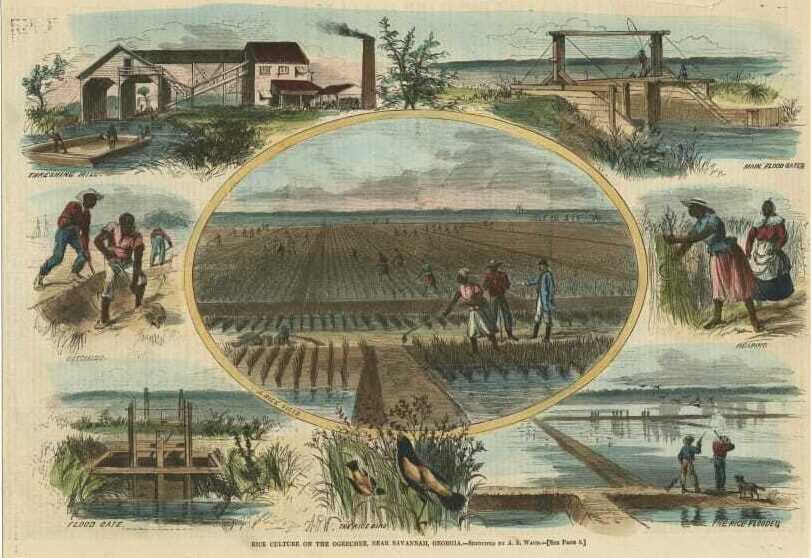Chapter 1
Enslaving Colonial North America
No African experience in the colonies was exactly the same. African people found themselves in different physical and social environments in the Chesapeake, the Lowcountry, Louisiana, and the Northern Colonies. Africans asserted new identities, created their own cultures, and resisted enslavement, while helping to build the physical, cultural, and intellectual foundations of colonial North America. By the end of the colonial period, race-based slavery was the law of the land and the basis of the economy. Africans were enslaved for life.
Malachy Postlethwayt was an economist and advocate of the slave trade. The author of The Universal Dictionary of Trade and Commerce in 1757, Postlethwayt was also employed by the government-sanctioned slave trading enterprise known as the Royal African Company. In 1745 Postlethwayt declared, “Are we not indebted to those valuable people, the Africans, for our Sugars, Tobaccoes, Rice, [and] Rum,” shedding light on the demand for and contributions of enslaved African people in the Western Atlantic World.

Gold Coast and Gambias [African people] are the best, next to them the Windward Coast are prefer’d to Angolas.
Henry Laurens, 1775
Roots & Routes: Forced Migration to the Lowcountry
Enslaved people in the Lowcountry were often from the Upper Guinea, a part of the African coast stretching from present-day Senegal to Liberia. During the colonial period, these regions were known as Senegambia, the Windward Coast, and Sierra Leone. Enslavers commonly preferred enslaved people from these regions of Africa, who were known for their expert skill in rice cultivation. At least 40% of enslaved people forced from Africa to the colonies entered through South Carolina.
The Lowcountry Region
Senegambia | 44,000 |
Sierra Leone | 32,000 |
Windward Coast | 1,900 |
Gold Coast | 28,000 |
Bight of Benin | 4,400 |
Bight of Biafra | 23,000 |
West Central Africa | 74,000 |
Southeast Africa | 1,500 |
The Lowcountry: Enslaving Skill in the Carolinas
By the 18th century, the Lowcountry population was majority enslaved: over 50% enslaved Africans and about 9% enslaved Native Americans, including the Kiawah, Stono, Edisto, Cherokee, Tuscarora, and Yamassee peoples. The Yamassee War (1715–1717), the rise of rice as the Lowcountry’s greatest export, and Charleston’s prominence as a slave port all shifted the focus to predominantly African slavery.
Enslavers were dependent on enslaved western Africans primarily from the Upper Guinea Coast. Generations of western Africans mastered rice production in their homelands by harnessing the tide and inland marshes. They carried this knowledge to America. Enslaved African people, through their skill and labor, transformed the landscape from dense swamp to rice fields, and made South Carolina one of the richest colonies before the Revolutionary War. By enslaving skill, enslavers reaped enormous profits and political power.
The Old Plantation
Landscape of Slavery
Slave Cabins and Main House at Mulberry Plantation
During the colonial period, the Lowcountry was a region of vast swamp and woodland. Enslaved African people labored in this inhospitable environment, working in the extreme heat and humidity and left exposed to diseases and dangerous wildlife. They toiled using only crude tools to tear down massive cypress and gum trees, clear the swamps, and dig vast rice fields six-to-eight feet deep. Their labor and advanced irrigation technology transformed the Lowcountry landscape and made Carolina enslavers rich.
Work in Africa
Building upon diverse experiences cultivating rice along the Upper Guinea Coast, Africans introduced sophisticated growing techniques and technologies to the Carolinas. For several centuries, Mande speakers cultivated rice by harnessing the water necessary to produce a crop. They controlled water using devices known as “rice trunks” to seasonally flood the fields for planting and to drain them for harvest. With these advanced systems of hydraulics, they regulated nature and used tides and floods to grow rice. Western African women participated heavily in the production of rice crops, including using mortar and pestles, and creating tools, such as the fanner basket, to clean the husks from the rice. These practices were transferred to the Lowcountry. Generations later, fanner baskets made in the Lowcountry still closely resemble those produced in Senegal.
Work in the Lowcountry
Rice Plantation Map
Drayton Hall Rice Sickle
With rice as the dominant crop in the Lowcountry, enslaved Africans with sophisticated knowledge of rice production brought a greater value in the Lowcountry slave trade. Lowcountry enslavers paid higher prices for people from the Windward Coast, Senegambia, and Sierra Leone. Much of what we know about enslaved African people in the colonies comes from records kept by enslavers like Charles Drayton. His writings, along with a sickle excavated from Drayton Hall, reveal one aspect of enslaved people’s lives—their work and their financial value as property. Yet even in his sparse comments, the individuality of enslaved people comes forward.
Rice Culture on the Ogeechee
Rice production required the difficult construction of banks and dikes, planting, weeding, harvesting, and threshing.
Life in the Lowcountry: Cultural Continuities
West African Pot
Enslaved African people not only brought their skills, but their cultural practices as well. In their actions and beliefs, they carried their traditions with them. In the Lowcountry, they found themselves among people from various parts of Africa, who spoke different languages, ate different food, and practiced different faiths. Together, they began to innovate, bridge divides, and create a new culture distinctive to the Lowcountry that emphasizes being part of a greater whole. This is often seen in what is known as the Lowcountry Gullah culture.
Colonoware from Cooper River Valley, South Carolina
Pottery fragments from colonoware, decorated with Xs or crosses, embody this connection. Many western African peoples believe there is a spiritual presence in everyday objects, and they marked the objects to unify the spirit and material worlds.
Escape from Slavery
Branding Iron
In the Lowcountry, where Africans greatly outnumbered Europeans, white enslavers used violence to enforce enslavement. Enslaved people faced death for striking any white person. Additional punishments included branding, slicing off ears, noses, hands, or feet, castration, plucking out eyes, and whipping. Each maimed person served as a warning to all. Sometimes, they were able to escape from the brutalities of slavery. Some sought refuge with communities of runaways, also known as maroons, deep in the cypress swamp landscape. Others ran towards Charleston, hoping to slip onto a boat heading elsewhere or to blend into the crowded city. Spanish Florida offered self-liberating enslaved people full freedom, if they could make it there without being discovered.
Runaway Ad
Throughout colonial North America fugitive enslaved African people ran towards someone—a friend or family member. Others left loved ones behind to escape bondage. All ran toward freedom. Runaway advertisements described a person’s appearance, speech, clothing, and personality. They provide rare details and valuable insight about the individuals who resisted slavery.
A Voice from the Lowcountry: Priscilla
Hare Ship Manifest Identifying Priscilla as Human Cargo
Humanizing Priscilla, a Silhouette
In 1756 slave traders kidnapped a 10-year-old girl, sold her into slavery, and placed her aboard the slave ship Hare bound for Charleston, South Carolina. During her forced migration across the Atlantic, where an average of one in five people perished, she witnessed the death of 16 fellow captives. Renamed Priscilla, she appears as a number on the second to last line of the Hare ship manifest. Henry Laurens, one of the wealthiest slave dealers in South Carolina, purchased Priscilla from slave merchants Samuel and William Vernon of Newport, Rhode Island. He then sold her to Elias Ball, also of South Carolina. Ball’s records show that Priscilla lived on several plantations and bore 10 children. The records say nothing about how she managed to survive enslavement including living among strangers and forming new families in the face of kidnapping, sale, and movement from plantation to plantation.
English establish Province of Carolina. | 1663 |
Fundamental Constitution of Carolina grants every free man “absolute Power and Authority over his Negro slave.” | 1669 |
Enslaved Africans flee from the Carolinas to Spanish Florida, where they were offered freedom. | 1693 |
Enslaved Africans represent over 50% of the Carolina population and rice becomes a staple crop. Enslaved Indians represent 9% of the colony’s population. | 1708 |
Yamassee War nearly destroys Carolina Colony and limits enslavement of Native Americans. | 1715 |
Rice becomes Carolina’s most lucrative export, supplanting trade in turpentine, wood, and enslaved Native Americans. | 1720 |
Charleston begins to dominate the Transatlantic Slave Trade in North America. Over 40 percent of all Africans shipped to North America enter through Charleston. | 1720 |
Stono Rebellion—enslaved Africans take up arms and attempt to march to Spanish Florida for freedom. | 1739 |
South Carolina Slave Code of 1740 imposes harsh surveillance upon people of color: “If such slave shall assault and stricke such white person, such slave may be lawfully killed.” | 1740 |
Spain cedes Florida to the English. | 1763 |

Carolina looks more like a negro country than a country settled by whites.
Samuel Dyssli, 1737
